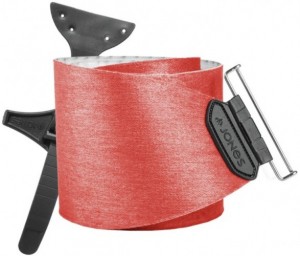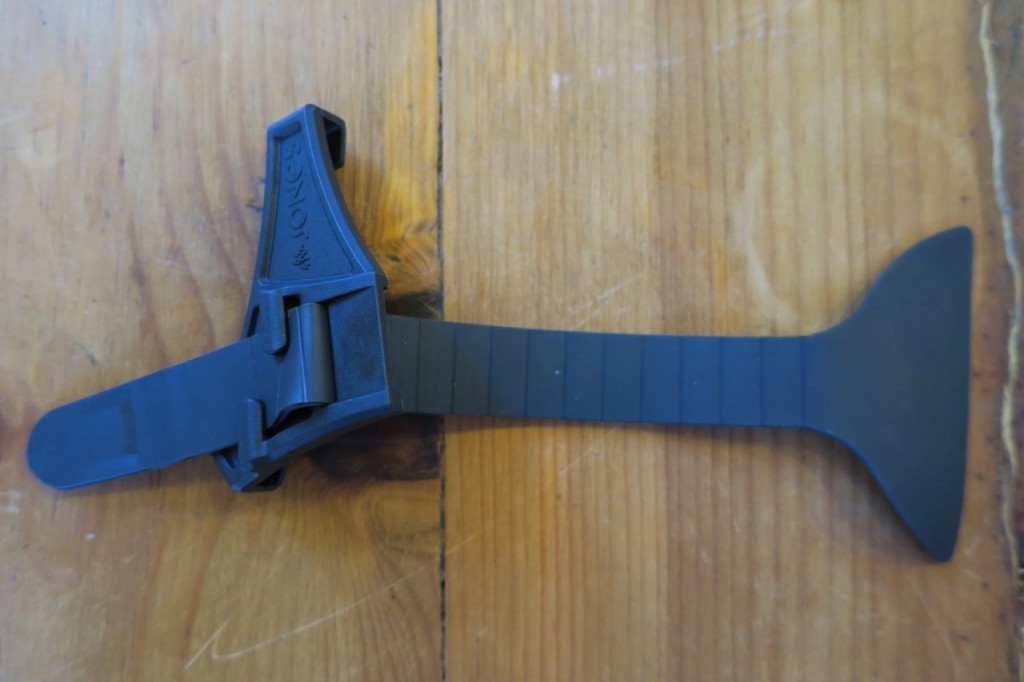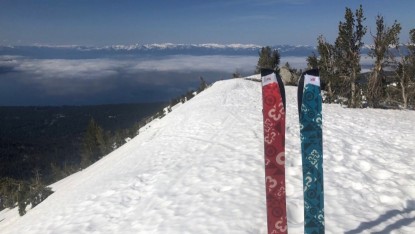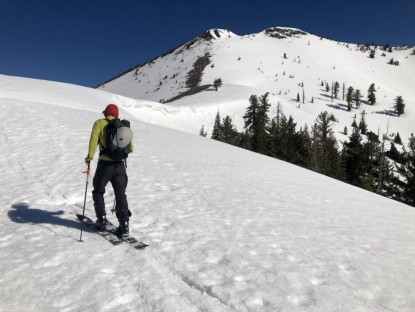The Jones Universal splitboard skin is replaced with the new Nomad model. Purchase links will take you to this new version (pictured in the main photo above) since it is more available from major retailers. Keep reading to learn more!
Jones Nomad Review
Our Verdict
The Jones Universal splitboard skin is replaced with the new Nomad model. Purchase links will take you to this new version (pictured in the main photo above) since it is more available from major retailers. Keep reading to learn more!
Our Analysis and Test Results
The New Jones Nomad vs. the Original Universal
Along with the name change, Jones also dropped the price by ten bucks! Check out the side-by-side comparison, showing the new Nomad on the left and the outdated Universal on the right.
Since we haven't yet got our hands on the new Nomad, the rest of this review continues to reflect the Universal.
Hands-On Review of the Jones Universal
While Jones offers the Universal skins in a Quick Tension clip version that fits their splitboards for the 2015-16 season, we reviewed the Universal Tail clip version that fits nearly every splitboard. These are the only nylon/mohair mix skins in our review and the balance between grip and glide was much appreciated by our review team. This model is manufactured by a European company, Pomoca, that manufacturers skins for a variety of different companies (our Jones skins clearly say Pomoco on the glue side).
Performance Comparison
Grip
This contender grips well and provides ample traction, provided that the user has decent technique. The grip is similar to the G3 Alpinist and a bit less than what is found on the Voile Skins with Tail Clip and the G3 Alpinist High Traction, making this balance close to ideal for most experienced splitboarders. We found these skins to grip well on slick skin tracks and firm corn conditions.
Glide
These skins really excelled in this category. On long mellow approaches and short descents where it doesn't make sense to remove your skins, the efficient glide afforded by these skins results in increased speed, reduced effort, and more energy for the down. It is a truism of climbing skins that solid technique can increase grip but technique can't make a overly grippy skin glide efficiently. Using a better gliding skin (like this model) can yield significant energy gains over the course of long days.
Ease of Use
We docked these skins in this category because they are the only model that required the tail clip to be attached by the consumer. If you are a crafting fiend, this will be no problem. Jones has a great video (with a sweet song) on their website demonstrating the steps necessary to measure and rivet the tail clip onto your skins. Being forced to do this yourself does allow you to position everything as you need it, which can be helpful if your board is a little longer, shorter, or weirder. If you have a phobia about rivets and looking at a hammer makes your thumb hurt, this DIY project might be a bit of a pain. Many ski shops will be happy to trim skins to skis and would also attach the tail clip for a fee.
Once this is installed, the tail clip works well and does its job. It is plastic, which is light but also does feel like plastic. However, we did not experience any issues with durability during the duration of our review. A significant positive in this category is that these skins are lighter and pack smaller than the Voile skins and the G3 High Tractions. In the mountains, less if often more and this competitor delivers valuable qualities in this category.
Attachment System
This model uses standard tip and tail connections. They work well, but are certainly not employing any innovative designs. Although lighter than the tip and tail connectors found on the Voile, this company uses similar designs.
Glue and Glop
The glue held up well during our testing. It sticks to the splitboard base as a skin should and pulls off with a reasonable amount of force. When stored and stuck to itself, the glue pulls apart easier than the Voiles, which is appreciated by those of us who don't do Crossfit six days a week. Good skins should last for several seasons of use, so our one season test is not a full gauge of durability, though the skin held up fine during our testing.
These skins come complete with a treatment to reduce glopping and keep them dry. We found that the skins faired about average, perhaps a little better than average, in terms of glopping resistance. During our testing we had a few days of horrendous glopping conditions where cold snow was warming up and transitioning to wet snow. On one of the worst days we experienced glopping on every skin in use, including this model. To be fair, on that particular day we also experienced glopping on the base of our splitboards and had to stop and scrape it off, then rub on wax to be able to ride downhill.
Best Applications
This pair of skins is recommended for any splitboarder, but especially someone who has experience skinning and has graduated past the initial stage of not trusting the skins to grip during cruxy switchbacks or slick skin tracks. Experienced splitboarders looking to move faster on approaches, cover more ground throughout the day, and conserve space in their packs will appreciate the benefits of these skins.
Value
At $209, these skins are the most expensive in our review, but only by about $25. We would expect them to last several seasons of use, making their value pretty reasonable despite the upfront investment.
Conclusion
The Jones Universal skins are the Top Pick Award winner. They are good choice for any splitboarder and especially recommended for experienced splitters due to their improved glide and reduced weight. We also appreciated that this company brought a mohair/nylon mix skin to the splitboard market. There are many ski specific mohair/nylon mix skins, but this model appears to be the first of splitboard specific mohair/nylon options. Remember to budget a little extra time to attach the tail clip before rushing to the trailhead with your new skins.








